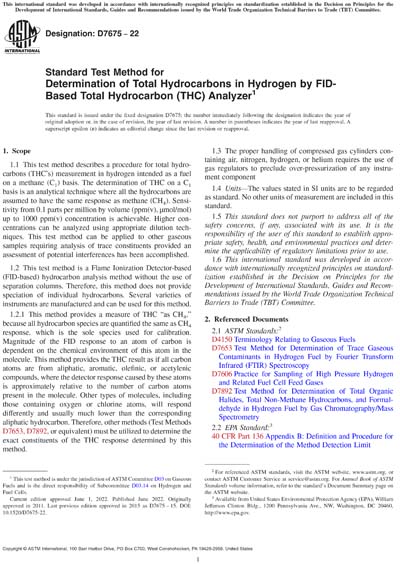Most recent
ASTM D7675-22
Standard Test Method for Determination of Total Hydrocarbons in Hydrogen by FID-Based Total Hydrocarbon (THC) Analyzer
1.1This test method describes a procedure for total hydrocarbons (THC's) measurement in hydrogen intended as a fuel on a methane (C1) basis. The determination of THC on a C1 basis is an analytical technique where all the hydrocarbons are assumed to have the same response as methane (CH4). Sensitivity from 0.1 parts per million by volume (ppm(v), µmol/mol) up to 1000 ppm(v) concentration is achievable. Higher concentrations can be analyzed using appropriate dilution techniques. This test method can be applied to other gaseous samples requiring analysis of trace constituents provided an assessment of potential interferences has been accomplished.
1.2This test method is a Flame Ionization Detector-based (FID-based) hydrocarbon analysis method without the use of separation columns. Therefore, this method does not provide speciation of individual hydrocarbons. Several varieties of instruments are manufactured and can be used for this method.
1.2.1This method provides a measure of THC "as CH4," because all hydrocarbon species are quantified the same as CH4 response, which is the sole species used for calibration. Magnitude of the FID response to an atom of carbon is dependent on the chemical environment of this atom in the molecule. This method provides the THC result as if all carbon atoms are from aliphatic, aromatic, olefinic, or acetylenic compounds, where the detector response caused by these atoms is approximately relative to the number of carbon atoms present in the molecule. Other types of molecules, including those containing oxygen or chlorine atoms, will respond differently and usually much lower than the corresponding aliphatic hydrocarbon. Therefore, other methods (Test Methods D7653, D7892, or equivalent) must be utilized to determine the exact constituents of the THC response determined by this method.
1.3The proper handling of compressed gas cylinders containing air, nitrogen, hydrogen, or helium requires the use of gas regulators to preclude over-pressurization of any instrument component
1.4Units - The values stated in SI units are to be regarded as standard. No other units of measurement are included in this standard.
1.5This standard does not purport to address all of the safety concerns, if any, associated with its use. It is the responsibility of the user of this standard to establish appropriate safety, health, and environmental practices and determine the applicability of regulatory limitations prior to use.
1.6This international standard was developed in accordance with internationally recognized principles on standardization established in the Decision on Principles for the Development of International Standards, Guides and Recommendations issued by the World Trade Organization Technical Barriers to Trade (TBT) Committee.
Content Provider
ASTM International [astm]






